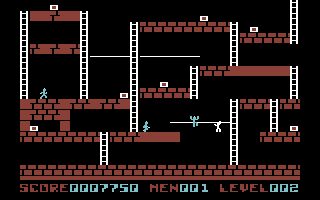
Author: GN Team - Published: 8 December 2019, 10:47 pm
Lode Runner is a puzzle platformer created by Douglas E. Smith and released initially for the Apple II, Commodore 64, Vic-20, and Atari 8-bit in 1983. It's one of the most popular video games ever created.
Douglas Smith started working on the concept when he was still a student. The first version was called Kong; it was programmed in FORTRAN and ran on ASCII terminals (the hero was a dollar sign "$"). Trying to convince some publishers, he rewrote the game in 6502 Assembler for the Apple II+, changing the name to Miner. But it was still black & white, with rough animations (despite stealing the frames of the running men from Dan Gorlin's Choplifter!), so not good enough to publish commercially. He accepted the offer from Brøderbund, taking $10,000 to finish the game, adding proper animations, sound effects, and 150 levels.
Read More
Author: GN Team - Published: 8 December 2019, 2:32 am
Roadkill is a violent racing sim with a top-down view created by Vision and released by Acid Software in 1994 for the Amiga CD32 and Amiga 1200.
The game, written in blitz basic, allows you to choose between six cars and drive against eight computer-controlled opponents. As you can imagine, it's not just pure racing because you will win money and bonuses by killing as many opponents as possible. Of course, eliminating your adversaries is not just about money; it's also a lot of fun.
As in Super Mario Kart, you will have to collect the power-ups, such as extra armor and missiles, that you will find spread on the tracks. Rockets are not the only way to kill the other cars; you can also try to push them against spikes and walls or force them to the Kill zone.
Read More
Author: GN Team - Published: 6 December 2019, 8:52 pm
Llamatron: 2112 (or simply LLamatron) is a shoot 'em-up created by Jeff Minter and released as shareware in 1991 for Amiga and Atari ST. Later it was also ported to MS-DOS.
It is, as you can expect, a clone of Robotron: 2084, except that the player controls a Llama and he has to save other animals from strange alien enemies. You can play with a friend, or you can ask the computer-controlled droid to help you. Fire is automatic, but if you hold the button, you will continue firing in the same direction while you can move with your llama. Plenty of powerups, such as love potions, new weapons, and bombs, will help you in your quest.
Read More
Author: GN Team - Published: 6 December 2019, 2:20 am
Disney's Tarzan (also known as Tarzan Action Game) is a platformer created by Eurocom Developments and published by Disney in 1999. Released for PlayStation and Windows, later, it was also ported to Nintendo 64.
Following the tradition of Disney's Aladdin, The Lion King, and (partially) Disney's Hercules, the studio converted the popular animation film, released the same year, into a side-scrolling platformer. In this case, the novelty is that the graphics are in 3D, with filled polygons. But the 3D is purely aesthetic because the movement happens only in one direction (horizontal). Technically speaking, it is known as 2.5D graphics. If, on one side, the third dimension doesn't help the gameplay, it is helpful to create a more realistic environment and beautiful parallax scrolling.
Read More
Author: GN Team - Published: 3 December 2019, 4:17 pm
Gold of the Americas: The Conquest of the New World is a historical strategy/simulation game created by SSG in 1989 for MS-DOS, Atari ST, and Amiga.
Ian Trout, founder of Strategic Studies Group, and author of Reach for the Stars: The Conquest of the Galaxy, designed the game together with Stephen Hart.
The game allows up to 4 players, in a hot-seat mode, to control the powers that colonized America in the 16th century: Spain, England, France, and Portugal. If you don't have three friends with you, the computer will care for the other factions. Beware because the AI is quite clever! You have 30 10-years turns to win the game by earning the highest number of colony points.
Read More
Author: GN Team - Published: 1 December 2019, 2:43 pm
James Pond 3: Operation Starfish is a platformer created by Vectordean and released in 1993. Unlike the previous two games of the series, James Pond 3 was created for the Sega Genesis / Mega Drive and only later ported to Amiga - but only AGA machines: Amiga 1200 and CD32. It was also released for the SNES and other platforms.
The gameplay is similar to the predecessors, and of course, the influence of Sonic or Super Mario is still visible. Anyway, there is quite a significant change: our hero James Pond can no longer stretch his body. Instead, he can use special boots to walk on the ceilings. This third chapter also emphasizes more than ever puzzle solving. There are plenty of power-ups: dynamites, jetpacks, cheese and gateaux guns, and plenty of enemies. The game is massive: over a hundred levels (plus some secret ones), and it's not easy. If James Pond 2: RoboCod was criticized for being too easy, this is not the case anymore.
Read More